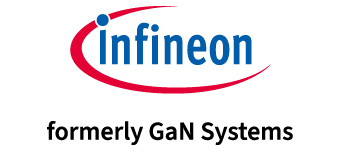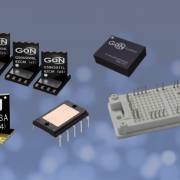Q&A: Wide Bandgap Semiconductors Poised to Make a Splash
This article was originally published here on June 10, 2020.
With silicon nearing its physical limits, electronics manufacturers are turning to non-traditional semiconducting materials, notably wide-bandgap (WBG) semiconductors. Some are adopting these technologies to hit cost and performance targets that otherwise can’t be reached, and while others seek to differentiate their products from their competitors’. Larry Spaziani, vice president of sales and marketing at GaN Systems sat down with EE Times to discuss the market prospects wide-bandgap semiconductors. Excerpts are below.
Because WBG materials have such wide bandgaps (compared to commonly used silicon), WBG devices can operate at high voltages, temperatures, and frequencies. The same quality can be exploited to extend battery life. Growing demand for improved energy efficiency and longer-lasting batteries are also helping to drive the WBG market.
EE Times: Where do you see the WBG market headed?
Larry Spaziani: The best off-the-cuff answer is, everywhere, but that’s not 100 percent true. It is true, however, that it will go almost everywhere. This projection can be gleaned from the following highlights of the various segments of the market:
GaN is already progressing into the AC/DC side with an explosion of GaN adapters hitting the market in late 2019 and ramping to huge volumes in 2020. Most AC/DC, phones, tablets and laptops will stay with silicon because the voltages are below 30 volts. Silicon still dominates this sector and will continue for quite some time. SiC hasn’t entered into this market other than occasional SiC diodes in adapters.
On the AC/DC side, power density is pushing 100W/in3 and efficiency to 99 percent, so WBG is absolutely required. SiC entered the market first with SiC diodes, but GaN is now starting to dominate in server switching power supplies. Server power is migrating to 48- and 100-volt GaN combined with low voltage silicon, which is beginning to ramp. By 2024, almost every server will be dominated by WBG on the AC/DC side and will have significant GaN content in the 48-volt AC/DC side.
Silicon still dominates most motor drives despite the high voltage. However, both GaN and SiC are making their way into motor drive systems in high-efficiency variable frequency drives. This market is highly conservative and will be slow to adapt to new technology, but by 2025, 10 percent to 15 percent of that market would have converted. The pace of conversion will pick up, as reliability and cost of WBG products meet market demands.
EET: How about the consumer market?
LS: This is a highly cost-sensitive market with a wide range of offerings. The high-end versions of these markets have already started converting to WBG, mostly GaN, based on prices and product offerings. Fifty percent of this part of the sector will convert by middle or late 2025.
In TV’s, very high-frequency AC/DC power supplies can be made ultra-thin. It allows very thin TV’s for the high-end market. In 2019 and 2020, most of the high-end audio systems also converted to GaN. With reduced prices, the lower-end consumer audio will also embrace it.
In appliances, global efficiency requirements and demands have forced high-end compressor motors and power factor correction circuits to adopt GaN and SiC. Again, as prices come down, the mid and lower-end products will adopt wide bandgap products as well.
EET: How about the hi-rel/military segment?
LS: This was, and still is, one of the fastest embracers of GaN and SiC, because of market values, performance, size and weight reductions. It’s also good for the market as it attests to the reliability of WBG compared to the others. Our GaN products have been proven to be somewhat immune to cosmic radiation, unlike silicon, so it has strong appeal in satellites.
EET: And the solar and energy storage sector?
LS: This market is very cost-sensitive and very cautious to take on new technology. But over the last five years, WBG products have slowly penetrated the market. For solar installations, higher voltage SiC has been very important because of the global voltages and de-rating required due to cosmic radiation. SiC is much better than IGBT’s for cosmic radiation performance. Although GaN is better than SiC, GaN doesn’t have the high voltages required for solar inverters quite yet.
Finally, there’s the automotive market. Going forward, this will be the largest market for WBG products. Owing to higher performance and higher reliability, GaN is quickly catching up in 2020 and into 2021.
In electric vehicle (EV) markets, on-board charging, AC/DC power conversion and traction inverters are being adopted.
EET: What are the dominant forces in the WBG market and who are the key players?
LS: The market forces that dominate decisions will determine the adoption rate and trends. In power electronics, WBG was first adopted in the form of SiC diodes to improve efficiency in switching power supplies. The early entry of SiC diodes had some quality problems, so we believe the overall dominant forces for WBG devices are cost and reliability. The major market that’s driving volumes is the EV market and the need for longer range EV’s and lower cost of batteries.
Another drive is cost. The power electronics market had been controlled by cost throughout the first decades of the 21st century. So, when WBG products entered the market at high prices, the market reception was slow. Leading companies’ adoption of WBG changed this. WBG devices from SiC and GaN companies are now on their fourth or fifth generation, and prices have approached or even beaten silicon prices in some areas, so adoption is picking up.
Reliability is also key. This market force is often assumed to be good because, for 30 years, silicon devices have proven to be very reliable. However, with the entry of WBG, and with the entry of new markets such as electric vehicles, reliability has become a dominant factor for WBG adoption.
We believe the real winners of the market will have reasonable cost with a roadmap to continue to lower cost, but also will have a large proven supply chain to assure customers with [stable] supply and reliability on the same order as silicon.
EET: How is the industry addressing the decade-old issues of high cost, limited volumes and constrained supply chains?
LS: Regardless of the technology, all customers care about cost and supply chain. In this respect WBG and silicon are similar. However, there are differences in SiC and GaN development.
Silicon is grown in ingots, which are then diced into wafers, while SiC is grown in boules, which are more difficult to ensure both in quality and quantity. At this point, one of the biggest concerns in the industry is the availability of SiC, once the EV market starts. Cree announced a $1 billion expansion of capacity in 2019, but considering the power discrete market is roughly $18 billion, this means there’s a limited supply.
Commercial and automotive GaN is developed on normal silicon wafers and use standards CMOS processes for the most part. The limitation in capacity is [epitaxial] chambers, which can be scaled to any volume given a 9- to 12-month lead time. For this reason, GaN does not have any limiting supply chain concerns.
Suppliers of SiC and GaN all have different technologies, so for the most part, there are no multiple sources. Customers, therefore, are approaching various sources at the systems level. For instance, in server power supplies, a data card can be developed with more than one supplier’s product, and both can be qualified. Other suppliers, such as GaN Systems, have multi-source agreements in place to alleviate customer concerns.
Regarding cost, SiC and GaN have reached the point of wide adoption in 2020, [yet] they still have low total market shares. Both of them will see compound annual growth rates through 2025 near 30 percent, as the costs have come down.


